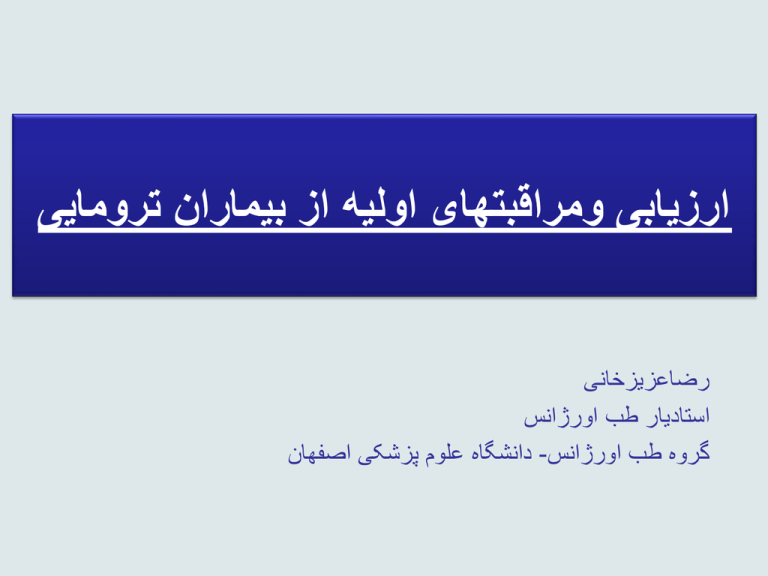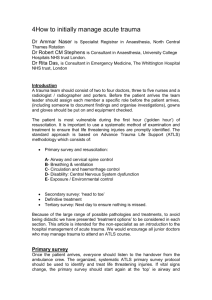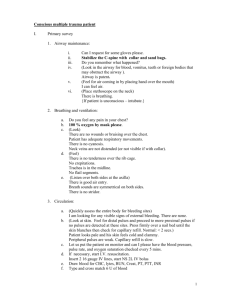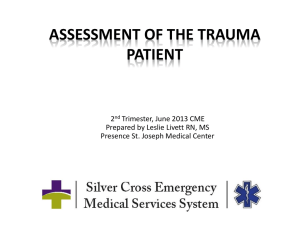
ارزیابی ومراقبتهای اولیه از بیماران ترومایی
رضاعزیزخانی
استادیار طب اورژانس
گروه طب اورژانس -دانشگاه علوم پزشکی اصفهان
Advanced Trauma Life Support
(ATLS)
Eight Edition
2008
Rule-Using Process
ALGORITHMIC METHOD
-In the algorithmic method, algorithms or flow charts are
used to simplify the decision making process into a
series of Steps. (ACLS ,ATLS , ...)
-The recognition of the pattern,
however, is a prerequisite
to applying the correct rule.
-To save considerable time and anxiety when clinicians
must make rapid decisions in life-threatening situations.
-For the optimal use of these protocols, physicians must familiarize
themselves with the scientific basis behind the algorithms.
Still in many situations, the algorithmic approach considerably
improves efficiency in the ED.
• Disadvantages:
1- Inflexible.
2-Remove independent thinking.
3- Not having the correct rule.
4- applying the correct rule improperly.
Levels Of Trauma Centers
• There are 4 trauma center levels:
Level 1 ; the highest level
Level 2 ; ………………..
Level 3 ; ………………..
Level 4 ; primary treatment
Essential Characteristics of Trauma Centers
Level IV
•
Initial care capabilities only
•
Mechanism for prompt transfer
•
Transfer agreements and protocols
•
•
•
Level III (not required of level IV trauma centers)
Trauma and emergency medicine services
24-h radiology capability
Pulse oximetry, central venous and arterial catheter monitoring
capability
• Thermal control equipment for blood and fluids
• Published on-call schedule for surgeons, subspecialists
• Trauma registry
Level II (not required of levels III and IV trauma centers)
• Cardiology, ophthalmology, plastic surgery, gynecologic surgery
available
• Operating room ready 24 h a day
• Neurosurgery department in hospital
• Trauma multidisciplinary quality assurance committee
Level I (not required of levels II, III, and IV trauma centers)
• 24-h availability of all surgical subspecialties (including cardiac
surgery/bypass capability)
• Neuroradiology, hemodialysis available 24 h
• Program that establishes and monitors effect of injury
prevention/education efforts
• Organized trauma research program
Course Overview
• The need
• History
– conception and inception
Trauma is a major source of morbidity and mortality in the
United States and world-wide.
the World Health Organization estimates that over 5 million
people died of traumatic injury in the year 2000,
accounting for 9% of global mortality and 12% of
the global disease burden.
Trauma is the first cause of death in ages 1-44 years old.
Trimodal death distribution
Head&Major vascular injury
Pre hospital phase
ICU
Late hospital phase
Head,chest,abdomen
Early hospital phase
Trauma
• part 1. Initial Assessment and
Management
Initial Assessment and Management
• Preparation
• Triage
• Primary survey (ABCDEs)
• Resuscitation
• Adjunct to Primary survey and Resuscitation
• Secondary survey
• Adjunct to Secondary survey
• Continued post resuscitation monitoring and
reevaluation
• Definitive care
Preparation
• Prehospital phase:
Rapid transport
Rapid triage
Notification
Triage
ISS ;(Injury Severity Score)
PTS;(Pediatric Trauma Score)
Weight, A.WAY,BP,GCS,Wounds,Fractures
RTS;(Revised Trauma Score):
GCS,BP,RR
Preparation
• Prehospital phase:
Rapid transport - Rapid triage - Notification
Air way ,
Pulse & Respiration ,
GCS,
Immobilization,
Iv line ,
Mechanism of injury ,
Anatomic sites of injury
• Multiple Casualties
• Mass Casualties
• Inhospital phase :
Before patient arrival
• -Trauma code
-Assign tasks to team members
-Check and prepare medical equipment.
Initial Assessment and Management
• Preparation
• Triage
• Primary survey (ABCDEs)
• Resuscitation
• Adjunct to Primary survey
• Secondary survey
• Adjunct to Secondary survey
Primary survey (ABCDE)
•
Airway and Cervical spine protection
•
Breathing and Ventilation
•
Circulation with control of external Hemorrhage,
•
Disability: Brief neurologic evaluation
•
Exposure/Environment: Completely undress the
patient, but prevent hypothermia
A. Airway + Cervical Spine Protection
• 1. Assessment
– a. Ascertain patency
– b. Rapidly assess for airway obstruction
• 2. Management
Establish a patent airway
– A. Clear the airway of foreign bodies
– B. Perform a chin lift or jaw thrust maneuver
– C.Insert an oropharyngeal or nasopharyngeal airway
– D. Establish a definitive airway
• Orotracheal or nasotracheal intubation
• Surgical cricothyroidotomy
– E.Describe jet insufflation of the airway, noting that it is only
a temporary procedure.
3. Maintain the cervical spine in a neutral position with
manual immobilization as necessary when
establishing an airway.
4. Reinstate immobilization of the c-spine with
appropriate devices after establishing an airway.
Clear and Suction
B. Breathing: Ventilation + Oxygenation
• 1. Assessment
– a. Expose the neck and chest: Assure immobilization of the head and neck.
– b. Determine the rate and depth of respirations.
– c. Inspect and palpate the neck and chest for tracheal deviation, unilateral
and bilateral chest movement, use of accessory muscles, and any signs of
injury.
– d. Percuss the chest for presence of dullness or hyperresonance.
– e. Auscultate the chest bilaterally.
• 2. Management
–
–
–
–
–
–
a. Administer high concentrations of oxygen.
b. Ventilate with a bag-valve-mask device.
c. Alleviate tension pneumothorax.
d. Seal open pneumothorax.
e. Attach a CO2 monitoring device to the endotracheal tube.
f. Attach the patient to a pulse oximeter.
Tension Pneumothorax
• Should be a clinical diagnosis
• Treat before X-ray
C. Circulation with Hemorrhage Control
• 1. Assessment
– a. Identify source of external, exsanguinating hemorrhage.
– b. Identify potential source (s) of internal hemorrhage.
– c. Pulse: Quality, rate, regularity, paradox.
– d. Skin color.
– e. Blood pressure.
• 2. Management
– a. Apply direct pressure to external bleeding site.
– b. Consider presence of internal hemorrhage and potential need
for operative intervention, and obtain surgical consult.
– c. Insert two large-caliber intravenous catheters.
– d. Simultaneously obtain blood for hematologic and chemical
analyses, pregnancy test, type and crossmatch, and arterial
blood gases.
– e. Initiate lV fluid therapy with warmed crystalloid solutions
and blood replacement.
– f. Apply the pneumatic antishock garment or pneumatic splints
as indicated to control hemorrhage.
– g. Prevent hypothermia ( increase mortality )
D. Disability: Brief Neurologic Examination
• Determine the level of consciousness
using the AVPU method or GCS Score.
• Assess the pupils for size, equality, and
reaction .
• Symmetric movement (SPI injury)
Disability
• Pupils
• Check awareness( loc ) :
AVPU
– A Awake
– V Responds to verbal command
– P Responds to pain
– U Unresponsive
Resuscitation
• Oxygenation and ventilation
• Shock management: intravenous lines,
warmed crystalloid solution.
• Management of life-threatening problems
identified in the primary survey is continued
F. Adjuncts to Primary Survey and
Resuscitation
• Obtain arterial blood gas analysis and respiratory rate.
• Attach the patient to an ECG monitor.
• Insert urinary and gastric catheters unless contraindicated and
monitor the patient's hourly urinary output.
• Consider the need for and obtain:
(1) AP chest x-ray,(2) AP pelvis x-ray, (3) lateral, crosstable cervical spine
• Consider FAST (Focous Abdominal Sonograhy Of Trauma)
the need for and perform DPL
G. Reassess the Patient's
ABCDEs and Consider Need for
Patient Transfer
Very important :Reassessment of ABCDE
IF PATIENT BECOMES UNSTABLE
II. SECONDARY SURVEY
AND MANAGEMENT
Secondary Survey
•
•
•
•
•
•
•
•
Head
Maxillofacial
Neck
Chest
Abdomen
Perineum/rectum/vagina
Musculoskeletal
Complete neurologic examination
Adjuncts to the Secondary Survey
• X-rays and diagnostic studies
– a. Chest
– b. Pelvis
– c. C-spine
– d. DPL
•
•
•
•
CT scan
Contrast X-ray studies
Extremity X-ray
Endoscopy and Ultrasonography
AMPLE History and Mechanism of Injury
• Obtain AMPLE history from patient, family,
or prehospital personnel
• Allergy
• Medication History
• Past Ilness/Pregnancy
• Last Meal
• Event
Head and Maxillofacial
• 1. Assessment
– a. Inspect and palpate entire head and face for lacerations,
contusions, fractures, and thermal injury.
– b. Reevaluate pupils( miosis- mydriasis).
– c. Reevaluate level of consciousness and GCS Score.
– d. Assess eyes for hemorrhage, penetrating injury, visual acuity,
dislocation of the lens, and presence of contact lens.
– e. Evaluate cranial nerve function.
– f. Inspect ears and nose for cerebrospinal fluid leakage,
hematoma
– g. Inspect mouth for evidence of bleeding and cerebrospinal
fluid,
soft-tissue lacerations, and loose teeth.
• 2. Management;
a . Maintain airway, continue ventilation and oxygenation
as indicated.
b. Control hemorrhage.
c. Prevent secondary brain injury;
Hypotension: SBP>90
Anemia: HB>10
Hypoxia:spo2>95%
d. Remove contact lenses.
Cervical Spine and Neck
• 1. Assessment
a. Inspect for signs of blunt and penetrating injury,
tracheal deviation, and use of accessory muscles.
b. Palpate for tenderness, deformity, swelling,
subcutaneous emphysema, tracheal deviation,
symmetry of pulses.
c. Auscultate the carotid arteries for bruits
d. Obtain a lateral, cross table cervical spine x-ray.
( nexus criteria ?)
NEXUS criteria
•
•
•
•
•
Cervical midline tenderness
Distracting injury
Abnormal level of consciousness ,cognition
Intoxication
Focal Neurologic Deficit(FND)
• 2. Management:
Maintain adequate in-line immobilization
and protection of the cervical spine.
Chest
• 1. Assessment
– a. Inspect the anterior, lateral, and posterior chest wall for signs
of blunt and penetrating injury, use of accessory breathing
muscles, and bilateral respiratory excursions.
– b. Auscultate the anterior chest wall and posterior bases for
bilateral breath sounds and heart sounds.( pediatric ?)
– c. Palpate the entire chest wall for evidence of blunt and
subcutaneous emphysema, tenderness, and crepitation.
– d. Percuss for evidence of hyperresonance or dullness.
Seat belt injury
Insert needle here
• 2. Management
a. Needle decompression of pleural space or tube
thoracostomy, as indicated
b. Correctly dress an open chest wound& sucking
wound
c. Pericardiocentesis, as indicated
Abdomen
• 1. Assessment
a. Inspect the anterior and posterior abdomen for signs of blunt
and penetrating injury and internal bleeding.
b. Auscultate for presence/absence of bowel sounds.
c. Percuss the abdomen to elicit subtle rebound tenderness.
d. Palpate the abdomen for tenderness, involuntary muscle
guarding, unequivocal rebound tenderness, gravid uterus.
Abdominal Trauma
•
•
•
•
Common site of injury
Assessment can be difficult
Site of “hidden haemorrhage”
Continual reassessment important
Early surgical consultation if possible
• 2. Management
a.Transfer the patient to the operating room, if
indicated.
b. Apply the pneumatic antishock garment, if
indicated, for the control of hemorrhage from a pelvic
fracture
c. Obtain a pelvic x-ray.
d. Perform diagnostic peritoneal lavage/abdominal
ultrasound( FAST)
Intra-peritoneal cavity extends upto 4th
intercostal space in thorax and to
7th vertebra from posterior
Perineum/Rectum/Vagina
• 1. Perineal assessment
– a. Contusions and hematomas
– b. Lacerations
– c. Urethral bleeding
• 2. Rectal assessment
–
–
–
–
–
a. Rectal blood
b. Anal sphincter tone
c. Bowel wall integrity
d. Bony fragments
e. Prostate position
• 3. Vaginal assessment
– a. Presence of blood in the vaginal vault
– b. Vaginal lacerations
Musculoskeletal
• 1. Assessment
– a. Inspect the upper and lower extremities for evidence of blunt
and penetrating injury, including contusions, lacerations, and
deformity.
– b. Palpate the upper and lower extremities for tenderness,
crepitation, abnormal movement, and sensation.
– c. Palpate all peripheral pulses for presence, absence, and equality.
– d. Assess the pelvis for evidence of fracture and associated hemorrhage.
– e. Inspect and palpate the thoracic and lumbar spine
for
evidence of blunt and penetrating injury, including
contusions,
lacerations, tenderness, deformity, and sensation
( log rolling)
– f. Evaluate the pelvic x-ray for evidence of a fracture.
– g. Obtain x-rays of suspected fracture sites as
indicated.
Don’t forget the back!
Secondary Survey
Log Roll
•
4 people(at least 3 people)
•
Airway/neck controller in change
•
Clear timing and instructions
•
Allows back examination
Secondary Survey; Log Roll
•
This examination concentrates on the back of the head,
neck, back, and buttocks, and includes a rectal
examination.
-The first person stabilizes the head and neck and manages
the airway.
-The second and third turn the patient.
-The fourth inspects and palpates the back .
Secondary Survey; Log Roll
Musculoskeletal cont’
• 2. Management
– a. Apply and/or readjust appropriate splinting devices for extremity
fractures as indicated
– b. Maintain immobilization of the patient's thoracic and lumbar spine.
– c. Apply the pneumatic antishock garment if indicated for the control of
hemorrhage associated with a pelvic fracture, or as a splint to immobilize
an extremity injury
– d. Administer tetanus immunization.
– e. Administer medications as indicated or as directed by specialist.
– f. Consider the possibility of compartment syndrome.
– g. Perform a complete neurovascular examination of the extremities
Neurologic
• 1. Assessment
– a. Reevaluate the pupils and level of consciousness.
– b. Determine the GCS Score.
– c. Evaluate the upper and lower extremities for motor
and sensory functions.
– d. Observe for lateralizing signs.
• 2. Management
– a. Continue ventilation and oxygenation.
– b. Maintain adequate immobilization of the entire
patient.
I. Adjuncts to the Secondary
Survey
• Additional spinal x-rays
• Extremity x-rays
• CT of the head, chest, abdomen, and/or spine
summary











